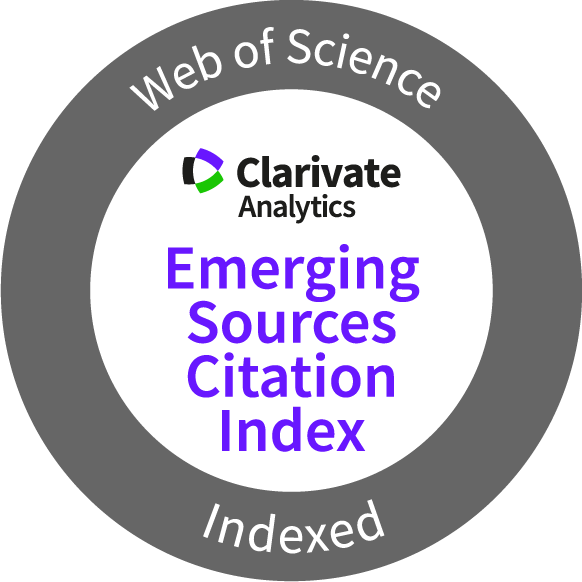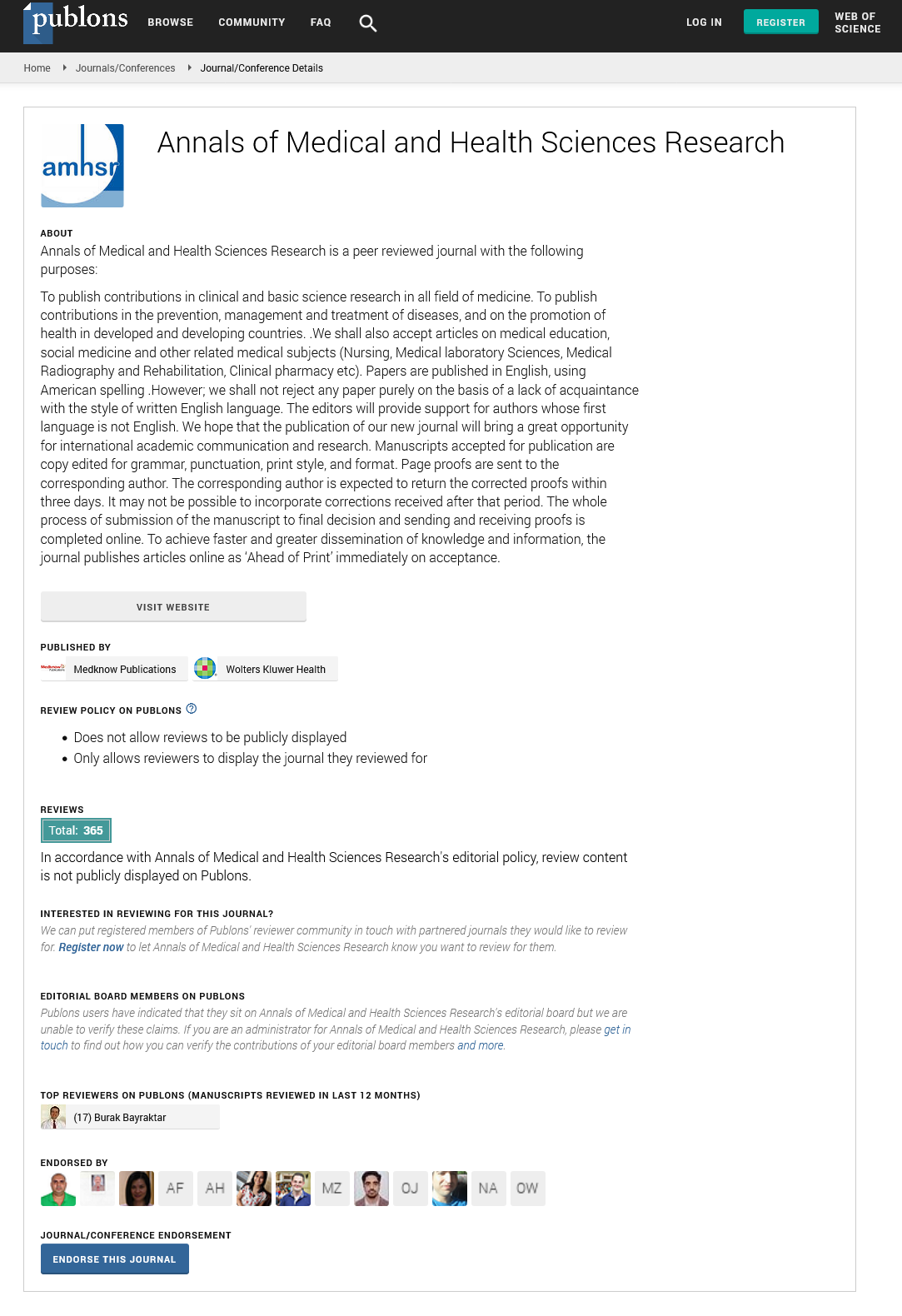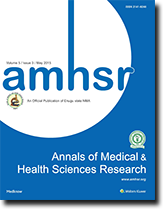Maternal Serum Lipids in Women with Pre‑eclampsia
- *Corresponding Author:
- Dr. Imran Akhtar Siddiqui
Department of Medical Education and Postgraduate Studies, Saudi Commission for Health Specialties, P.O. Box 94656, Riyadh 11614, Saudi Arabia.
E-mail: siddiquiimra@gmail.com
Citation: Siddiqui IA. Maternal serum lipids in women with pre-eclampsia. Ann Med Health Sci Res 2014;4:638-41.
Abstract
Background: Evidence of increased oxidative stress due to endothelial dysfunction in pre‑eclampsia has been well‑established. Increase in the oxidative stress is associated with abnormal lipid profile. Aim: The aim of the study is to compare serum lipids in pre‑eclamptic women and healthy pregnant women. Subjects and Methods: In this case‑control study, blood samples were collected from 40 pregnant females diagnosed as pre‑eclampsia and 80 normal pregnant females at the Department of Obstetrics and Gynecology at King Abdulaziz Medical City, Riyadh, Kingdom of Saudi Arabia between February 2009 and January 2010. We evaluated serum levels of total cholesterol, low‑density lipoprotein and high‑density lipoprotein cholesterol and triglyceride in women with pre‑eclampsia and those of women with normal pregnancies. Data was analyzed using SPSS for Windows (version 17.0, SPSS Inc., Chicago, Illinois, USA). The data is presented descriptively and test for significance was done using the student t‑test for continous data. Results: Women with pre‑eclampsia exhibited higher serum triglyceride levels compared with normal pregnant women (P < 0.01). Other measured serum lipids did not differ significantly in the two groups. Conclusion: We recommend that any pregnant female with higher serum triglyceride concentrations may be further investigated for pre‑eclampsia. Further large scale multicenter studies are required to establish the use of measuring serum triglyceride levels to screen the pregnant females for pre‑eclampsia.
Keywords
Lipids, Pre-eclampsia, Triglycerides
Introduction
Pre-eclampsia with a frequency of 3-7% is a pregnancy related disorder constituting one of the leading causes of fetal and maternal morbidity and mortality world-wide.[1,2] It is more frequent in nulliparous young women and in older multiparous women.[3] Pre-eclampsia is characterized by the new onset of hypertension and proteinuria occurring from 20 weeks of gestation onward.[4]
Despite being the one of the leading causes of the maternal morbidity and mortality, the etiology and pathogenesis of pre-eclampsia remain to be elucidated. Until date, endothelial dysfunction in the placental vasculature is considered as a widely accepted theory for the etiology and the pathogenesis of the disease.[5] Several other factors including genetic, immune, vascular and oxidative stress are also implicated in the pathogenesis of pre-eclampsia, which lead to the studies for identification of potential screening markers of the disease.[6]
Studies in the field of cardiovascular research have shown that serum lipids have a direct effect on endothelial function and in this way, abnormal serum lipid profiles are also associated with endothelial dysfunction.[7] Recent published work have suggested that a maternal pre-disposition to pre-eclampsia may be explained by altered lipid profile, but the reported findings are inconsistent.[8-10] Therefore, the present study was designed with the aim to investigate the alteration in serum lipid profile including total cholesterol, high-density lipoprotein (HDL)-cholesterol, low-density lipoprotein (LDL)-cholesterol and triglycerides in pre-eclamptic and normal pregnant women.
Subjects and Methods
This is a case-control study, which is approved from the King Abdullah International Medical Research Center, Riyadh,Saudi Arabia for the scientific aspects of the protocol and then sent to the Institutional Review Board (IRB) to review the ethical aspects of the protocol. Upon the recommendations of the research committee, the IRB granted permission to conduct this study.
The study population comprised of 120 pregnant females, selected from women attending the Obstetrics and Gynecology Department of a University Hospital, Saudi Arabia between February 2009 and January 2010. Among 120 pregnant females, 40 were eligible cases who were singleton pregnancies with the diagnosis of pre-eclampsia according to the criteria for the definition of pre-eclampsia given by the International Society for the Study of Hypertension in Pregnancy.[11] Pre-eclampsia was diagnosed in previously normotensive women with two repeat (at least 4 h apart) diastolic blood pressure measurements of 90 mmHg or greater after the 20th week of gestation, plus proteinuria of more than 300 mg/l in 24 h as measured quantitatively or >2+ protein with dipstick and 80 were non-preeclamptic and otherwise healthy pregnant females. Those women who were in labor, with ruptured membranes or with multiple pregnancies were not recruited in the study. The pregnant females with any known concurrent medical complications were also excluded. The control group comprised a consecutive sample of pregnant women followed-up at our setting and undergoing routine late second or third-trimester blood analysis and with none of the exclusion criteria.
No cases or controls received vitamin supplements or aspirin in the month before enrollment. We explained about the study to those pregnant females who agreed to participate in the study and were asked to sign the informed consent form. Enrolment of the patients and controls for the study was done by twice daily visits to the wards. We explained about the study to those who agreed to participate in the study and were asked to sign the informed consent form. A total volume of 5 ml of venous blood was drawn from the antecubital vein, after proper aseptic precautions, into sterile and disposable plastic syringes. After removing the needle, the blood was left in the syringe, covered with foil and transported in a cool vaccine box to the laboratory within 3 h. Tubes were centrifuged for 15 min at 3000 rpm to separate sera. The sera after separating from blood samples were stored at −80°C until further analysis for the following parameters:
Serum triacylglycerol was estimated by the enzymatic colorimetric method (GPO-PAP), using kit cat no. 7D74-20 supplied by Abbott. Serum total cholesterol was estimated by the enzymatic method using kit (cholesterol) cat no. 7D62-20 supplied by Abbott. Serum HDL-cholesterol was estimated by the accelerator selective detergent method kit (ultra HDL) cat no. 3K33 supplied by Abbott and serum LDL-cholesterol was estimated by the accelerator selective detergent method kit (direct LDL) cat no. 1E31-20 supplied by Abbott. All these parameters of lipid profile were recorded for both groups.
Statistical analysis
Data was analyzed using SPSS for Windows (version 17.0, SPSS Inc., Chicago, Illinois, USA). The data is presented descriptively, providing the number of women, mean values and standard deviations. The differences between preclamptic cases and normal pregnant women were investigated using t-test for continous data.
Results
The included cases and controls were Saudi nationals with singleton pregnancies. The age of the studied pregnant females ranged between 16 and 42 years. The mean age of cases (pre-eclamptic) and controls (normal) pregnant women was 29.6 (6.1) and 29.5 (6.1) years respectively. There was no statisticaly significant difference in the maternal ages of both groups (P = 0.952). Body mass index, which was only recorded at the time of blood sampling was not significantly different (P = 0.387). Mean systolic and diastolic blood pressures were significantly higher in pre-eclamptic group than in the normal pregnant groups. Mean gestational ages of both groups at the time of blood sampling was not significantly different statistically (P = 0.311), shown in Table 1.
| Physicalvariables | Mean (SD) | P value | |
|---|---|---|---|
| Pre-eclampsia | Normal | ||
| (n=40) | (n=80) | ||
| Age (years) | 29.6 (6.1) | 29.5 (6.1) | 0.952 |
| BMI (kg/m2) | 32.0 (6.3) | 31.1 (5.2) | 0.387 |
| Systolic bloodpressure (mmHg) | 143.1 (7.8) | 125.1 (19.6) | <0.01* |
| Diastolic bloodpressure (mmHg) | 94.3 (4.9) | 78.0 (13.3) | <0.01* |
| Gestational ageat blood sampling(weeks) | 24.8 (5.9) | 25.2 (5.2) | 0.311 |
Table 1: Age, BMI, systolic and diastolic blood pressures of pre-eclamptic and normal pregnant groups
Mean serum triglyceride concentartions in pre-eclamptic and controls normal pregnant women were 3.1 (0.8) mmol/l and 2.5 (0.9) mmol/l respectively. There was significantly high serum triglyceride concentration (P < 0.01) in the pre-eclamptic group than in the normal pregnant women. No significant differences were observed in other measured lipid profile including total cholesterol, HDL and LDL [Table 2]. A positive correlation (r2 = 0.82) was observed between systolic blood pressure and serum triglyceride levels.
| Serum lipids(mmol/l) | Mean (SD) | P value | |
|---|---|---|---|
| Pre-eclampsia(n=40) | Normal (n=80) | ||
| Total cholesterol | 6.7 (1.3) | 6.4 (1.3) | 0.284 |
| HDL | 1.5 (0.3) | 1.5 (0.4) | 0.817 |
| LDL | 3.9 (1.1) | 3.8 (1.0) | 0.561 |
| Triglyceride | 3.1 (0.8) | 2.5 (0.1) | <0.01* |
Table 2: Comparison of serum total cholesterol, HDL, LDL and triglyceride between the pre-eclampsia and normal pregnant groups
Discussion
Few studies have described lipid alterations in pregnant patients who developed pre-eclampsia compared with the pregnant women with no pre-eclampsia.[12,13] In these studies, significantly higher concentrations of serum triglycerides in pre-eclamptic were find out than in the normal pregnant women was find out which is in good agreement with previous larger studies.[14-17] Enquobahrie et al.[8] assessed serum lipid levels in 57 patients with pre-eclampsia and 510 pregnant women in the control group and they found significantly higher levels of triglycerides in pre-eclampsia. The association between hypertriglyceridemia and pre-eclampsia at 28-37 weeks gestation was evaluated in a study in the United States. In that study pregnant women with pre-eclampsia had a significant increase in the plasma triglyceride levels than in controls.[18] In another study performed in Spain, at 20 and 34 weeks gestation, triglyceride levels were significantly higher in women with severe gestational hypertension than in controls, which is also in agreement with our findings.[19] However, it is worth mentioning a few previous studies, which have not mentioned any differences in lipid parameters in both groups.[20,21]
In the pathogenesis of pre-eclampsia, the initiating event has been postulated to be the reduced placental perfusion that leads to widespread dysfunction of the maternal vascular endothelium by mechanisms that are not well-defined.[22] Mikhail et al. described that increased serum triglyceride levels leads to its increased endothelial accumulation, which may results in endothelial dysfunction in pregnancy.[18] Increased triglycerides in pre-eclampsia are likely to be deposited in uterine spiral arteries and contribute to the endothelial dysfunction, both directly and indirectly through generation of small, dense LDL.[17]
No significant difference in mean total cholesterol concentration in the pre-eclamptic group when compared with that in normal pregnant group was find out which is in accordance with the findings reported by Enquobahrie et al. and Clausen et al.[8,12]
In this study, though a rise in LDL concentration in pre-eclamptic women was observed, but it did not reach to the significant level which is in accordance with findings reported by Chappell et al.[23] On the contrary, some studies showed significant rise in LDL concentration in pre-eclamptic women than in normal pregnant women.[8,24]
There is no decrease in serum HDL levels in the pre-eclamptic group. This finding is in agreement with results of the study performed by Kaaja et al. in which they compared serum lipoprotein levels in 31 pregnant women with pre-eclampsia and 21 healthy pregnant controls and found no significant difference in the HDL levels of both groups.[25] Bayhan et al. assessed 25 pregnant women that developed mild pre-eclampsia, 28 pregnant women that developed severe pre-eclampsia and 25 pregnant women in a control group, during the third trimester and found a significant decrease in HDL levels in patients that developed pre-eclampsia.[26]
This study showed a positive correlation between the systolic blood pressure and serum triglyceride levels, indicating the implication of raised serum triglyceride levels in the pathogenesis of pre-eclampsia as also described by Roberts and Redman.[27]
Limitations of this study are worth mentioning here. First, non-fasting blood samples was used which may have introduced variation in lipid measurements. The reason was that in these study participants were pregnant, so they were not asked to fast before the blood sample collection. Results of this study are in concordance with other studies those also used non-fasting blood samples for the measurements of lipids.[10,12] Second, it would be more appropriate to perform serial measurements for lipoproteins to study patterns of their changes. Finally, the smaller number of recruited pregnant females with pre-eclampsia is one of the limitations of this study, which might have affected the power of the study. Although, to overcome this, we recruited normal pregnant females as a control near twice than the cases in order to maximize the power of the study.
Conclusion
These results have shown that there are no statistical differences in total cholesterol, HDL and LDL concentrations between pre-eclamptic women and normal pregnant women, therefore not related with the diseases. However, elevated serum triglycerides might be involved in the endothelial damage leading to pre-eclampsia. Moreover, raised serum triglycerides may have value to be used as screening markers in early stages of pregnancy for the development of pre-eclampsia later. Therefore, further studies in the future, involving multiple centers and recruiting higher numbers of cases would be able to confirm our findings.
References
- RobertsCL, AlgertCS, MorrisJM, FordJB, Henderson-SmartDJ. Hypertensive disorders in pregnancy: A population-based study. Med J Aust 2005;182:332-5.
- Report of the national high blood pressure education program working group on high blood pressure in pregnancy. Am J Obstet Gynecol 2000;183:S1-22.
- Mahaba HM, Ismail NA, El Damaty SI, Kamel HA. Pre-eclampsia: Epidemiology and outcome of 995 cases. J Egypt Public Health Assoc 2001;76:357-68.
- Sibai B, Dekker G, Kupferminc M. Pre-eclampsia. Lancet 2005;365:785-99.
- Young BC, Levine RJ, Karumanchi SA. Pathogenesis of preeclampsia. Annu Rev Pathol 2010;5:173-92.
- Myatt L, Miodovnik M. Prediction of preeclampsia. Semin Perinatol 1999;23:45-57.
- Sima AV, Stancu CS, Simionescu M. Vascular endothelium in atherosclerosis. Cell Tissue Res 2009;335:191-203.
- Enquobahrie DA, Williams MA, Butler CL, Frederick IO, Miller RS, Luthy DA. Maternal plasma lipid concentrations in early pregnancy and risk of preeclampsia. Am J Hypertens 2004;17:574-81.
- Baksu B, Baksu A, Davas I, Akyol A, Gülbaba G. Lipoprotein(a) levels in women with pre-eclampsia and in normotensive pregnant women. J Obstet Gynaecol Res 2005;31:277-82.
- Belo L, Caslake M, Gaffney D, Santos-Silva A, Pereira-Leite L, Quintanilha A, et al. Changes in LDL size and HDL concentration in normal and preeclamptic pregnancies. Atherosclerosis 2002;162:425-32.
- Brown MA, Lindheimer MD, de Swiet M, Van Assche A, Moutquin JM. The classification and diagnosis of the hypertensive disorders of pregnancy: Statement from the international society for the study of hypertension in pregnancy (ISSHP). Hypertens Pregnancy 2001;20:IX-XIV.
- Clausen T, Djurovic S, Henriksen T. Dyslipidemia in early second trimester is mainly a feature of women with early onset pre-eclampsia. BJOG 2001;108:1081-7.
- Koçyigit Y, Atamer Y, Atamer A, Tuzcu A, Akkus Z. Changes in serum levels of leptin, cytokines and lipoprotein in pre-eclamptic and normotensive pregnant women. Gynecol Endocrinol 2004;19:267-73.
- Lorentzen B, Drevon CA, Endresen MJ, Henriksen T. Fatty acid pattern of esterified and free fatty acids in sera of women with normal and pre-eclamptic pregnancy. Br J Obstet Gynaecol 1995;102:530-7.
- Ziaei S, Bonab KM, Kazemnejad A. Serum lipid levels at 28-32 weeks gestation and hypertensive disorders. Hypertens Pregnancy 2006;25:3-10.
- Gratacós E, Casals E, Gómez O, Llurba E, Mercader I,Cararach V, et al. Increased susceptibility to low density lipoprotein oxidation in women with a history of pre-eclampsia. BJOG 2003;110:400-4.
- Sattar N, Bendomir A, Berry C, Shepherd J, Greer IA,Packard CJ. Lipoprotein subfraction concentrations in preeclampsia: Pathogenic parallels to atherosclerosis. Obstet Gynecol 1997;89:403-8.
- Mikhail MS, Basu J, Palan PR, Furgiuele J, Romney SL,Anyaegbunam A. Lipid profile in women with preeclampsia:Relationship between plasma triglyceride levels and severity of preeclampsia. J Assoc Acad Minor Phys 1995;6:43-5.
- Gratacós E, Casals E, Sanllehy C, Cararach V, Alonso PL, Fortuny A. Variation in lipid levels during pregnancy in women with different types of hypertension. Acta Obstet Gynecol Scand 1996;75:896-901.
- Chalas J, Audibert F, Francoual J, Le Bihan B, Frydman R, Lindenbaum A. Concentrations of apolipoproteins E, C2, and C3 and lipid profile in preeclampsia. Hypertens Pregnancy 2002;21:199-204.
- Vanderjagt DJ, Patel RJ, El-Nafaty AU, Melah GS, Crossey MJ, Glew RH. High-density lipoprotein and homocysteine levels correlate inversely in preeclamptic women in Northern Nigeria. Acta Obstet Gynecol Scand 2004;83:536-42.
- Gilbert JS, Ryan MJ, LaMarca BB, Sedeek M, Murphy SR, Granger JP. Pathophysiology of hypertension during preeclampsia: Linking placental ischemia with endothelial dysfunction. Am J Physiol Heart Circ Physiol 2008;294:H541-50.
- Chappell LC, Seed PT, Briley A, Kelly FJ, Hunt BJ, Charnock-Jones DS, et al. A longitudinal study of biochemical variables in women at risk of preeclampsia. Am J Obstet Gynecol 2002;187:127-36.
- Setareh A, Mitra M, Sedigheh B, Shoaleh S, Vahid Y, Siroos S. Maternal plasma lipid concentrations in first trimester of pregnancy and risk of sever preeclapmsia. Pak J Med Sci 2009;25:563-7.
- Kaaja R, Tikkanen MJ, Viinikka L, Ylikorkala O. Serum lipoproteins, insulin, and urinary prostanoid metabolites in normal and hypertensive pregnant women. Obstet Gynecol 1995;85:353-6.
- Bayhan G, Koçyigit Y, Atamer A, Atamer Y, Akkus Z. Potential atherogenic roles of lipids, lipoprotein (a) and lipid peroxidation in preeclampsia. Gynecol Endocrinol 2005;21:1-6.
- Roberts JM, Redman CW. Pre-eclampsia: More than pregnancy-induced hypertension. Lancet 1993;341:1447-51




 The Annals of Medical and Health Sciences Research is a monthly multidisciplinary medical journal.
The Annals of Medical and Health Sciences Research is a monthly multidisciplinary medical journal.